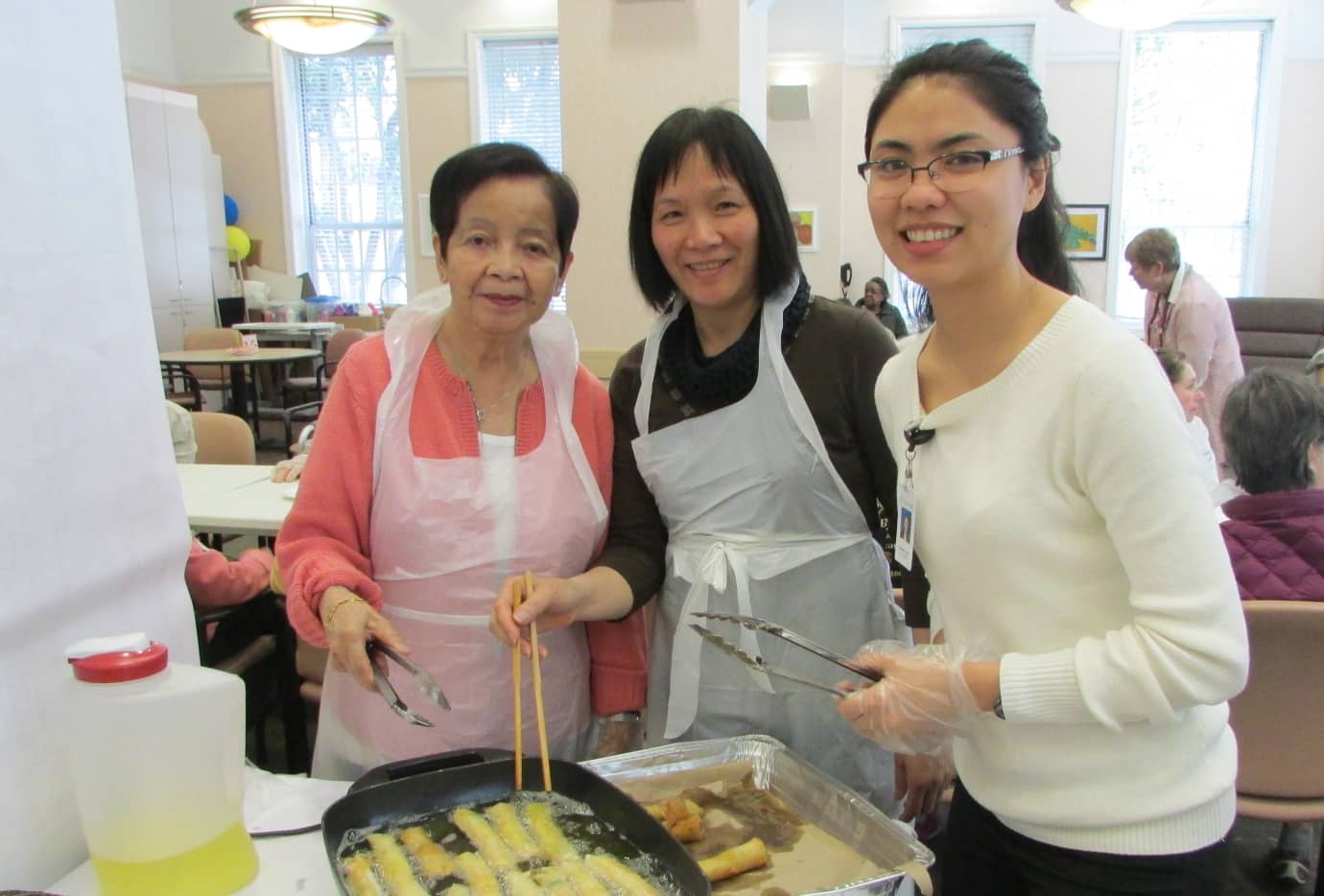Contributors: Micah Apruebo, Sherry Lifton and Kim Pham
Every time you visit an On Lok PACE center, there is something going on: singing, smiling with medical clowns, chair yoga, painting, sewing, Wii bowling and many other fun activities. Why not go to an art exhibit or a poetry reading? Each center exhibits art made by the participants worthy of any art gallery, and our participants freely express their artistic talents by reading their own poems or singing. Without activities scheduled by the On Lok PACE activity staff, our centers would be diminished.
Activity therapy is an umbrella that covers various specialty fields, including recreation and art therapy. The purpose of activity therapy is to use different modalities for the therapeutic practice to accomplish set goals for patients. The On Lok PACE staff have various specialties, language and culture skills to meet the needs of the diverse participants at every center. While some activities and programs are the same, each center creates its own activity therapy programming based on the needs and interests of the participants. To do this, the activity staff carefully completes an initial assessment to better understand participants’ past, current and future leisure interests.
The activity staff also observes participants at each center and creates meaningful connections with each of them. In addition, each participant is assessed on a quarterly and six-month basis to evaluate his or her overall well-being. Activity therapy is founded on several key values. It needs to be therapeutic and include a health component that aims to improve mind, body and spirit for each participant. Meaningful connection is another essential value. Every activity needs to be meaningful for a participant.
“Just because you see us having a good time with our participants, you may not notice the important underlying goals of each activity,” says Kim Pham, Activity Therapist at the On Lok PACE Center in San Jose with a specialty in recreation therapy. Creating a sense of community and opportunities for each older adult to engage in regardless of their physical and cognitive levels of impairment is at the core of the activity therapy programming. And the key difference between activity and activity therapy is the therapeutic values and goals.
The majority of the activities are organized as a group therapy, and participants are seated in circles or semicircles, helping create an interactive environment. Even those who may not be interested in participating in a certain activity benefit from being present when the activity is taking place. There are also certain activities that participants can do on their own, such as art projects, word searches, sudoku and other solitary activities.
Intergenerational Learning
Our outstanding volunteers are also involved in this type of therapy by interacting with the participants on an individual basis, reading together, sharing stories and simply enjoying each other’s company. For example, the San Jose Center greatly benefits from Project SHINE, an intergenerational and intercultural community learning program at San Jose State University. Project SHINE students come to volunteer with our participants at the San Jose Center, and the connections created are meaningful for all! We have volunteer projects for our participants too. For example, participants at the Fremont and Peralta PACE centers visit the Hip and Joint Replacement Center at Washington Hospital on a monthly basis to make art and decorations. The art created by the older adults stays at the hospital for patients to enjoy and is also used for cards to be sent to patients. The participants at the San Jose Center are now making felt stuffed animals on Fridays, and the plan is to donate these to the Children’s Hospital.
A Whole-Person Approach
“Medicine is limited. Emotional and cognitive engagement is especially important for older adults. In creating activities, we look at each participant as a whole person; we evaluate their well-being and the impact of the activity therapy,” notes Sherry Lifton, Activity Therapist at the On Lok 30th Street Senior Center.
“What inspires me in my daily work routine? Our participants! Their excitement when they accomplish a project is inspiring.” The Activity Department in the On Lok PACE program has been collaborating closely with the CEYA Program at the Institute on Aging. Among the most recent accomplishments are a beautiful mural made of fabric cubes painted by our participants at the Powell Center and inspiring poems in English and Spanish at 30th Street Senior Center. The Grandriders, a group of Taiwanese octogenarians, visited the On Lok PACE Center and On Lok 30th Street Senior Center as part of their four-day, three-night Miracle Tour on motorcycle from San Francisco to Los Angeles. Seniors from both centers benefited from a group Qi Gong exercise in the garden. Research into the healing role of creative arts and activity therapy suggests a number of benefits for older adults: improved health, increased positive mood, positive role identity, increased satisfaction with life, increased quality of life, lower medical costs (e.g., decreased reliance on pain medications), greater sense of social connection and successful positive aging! The On Lok PACE Activity Department staff work daily to help the participants enjoy life in the community for as long as possible.
For more great information on maintaining a safe lifestyle while aging and to learn more about On Lok’s services, please explore our website.
